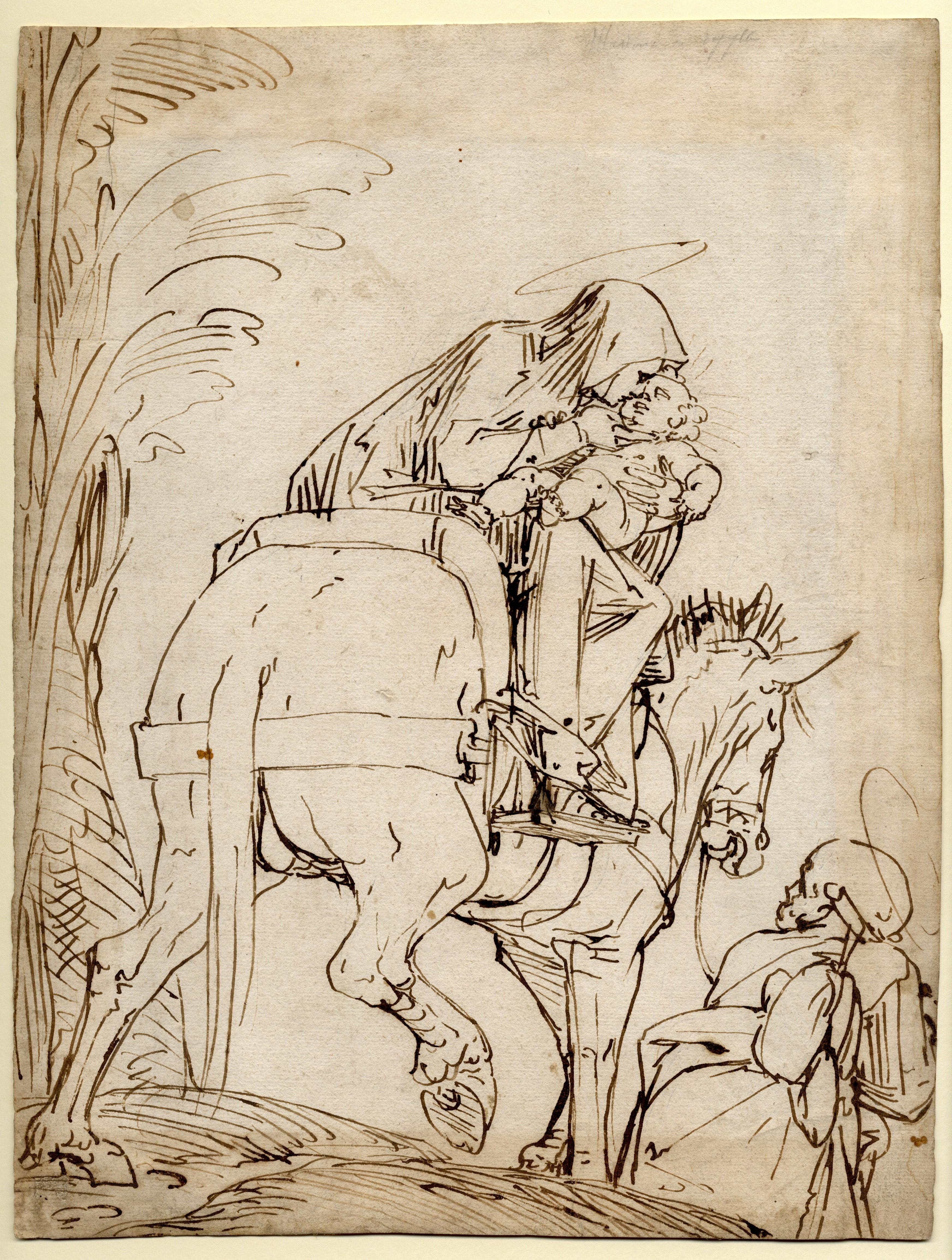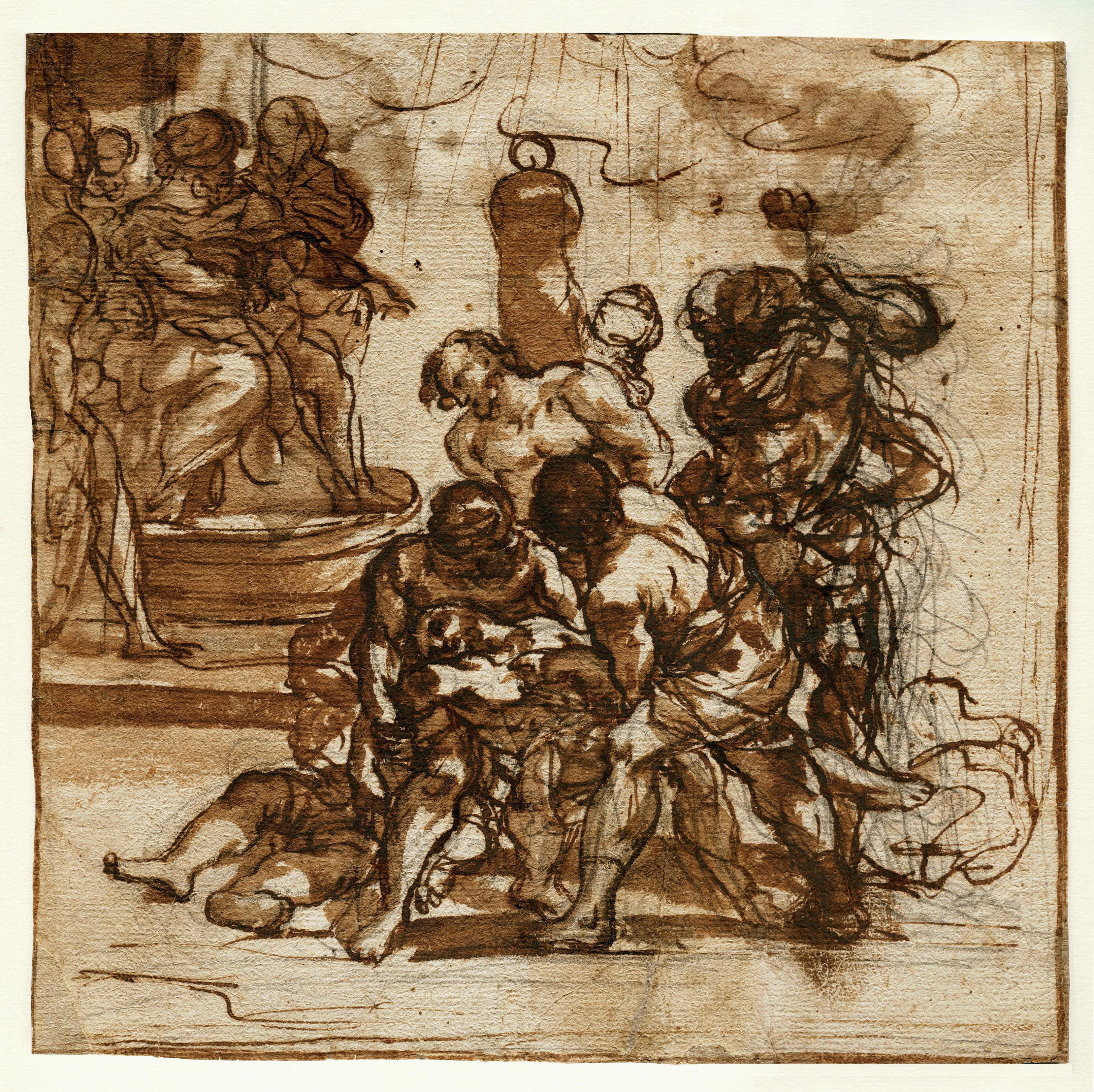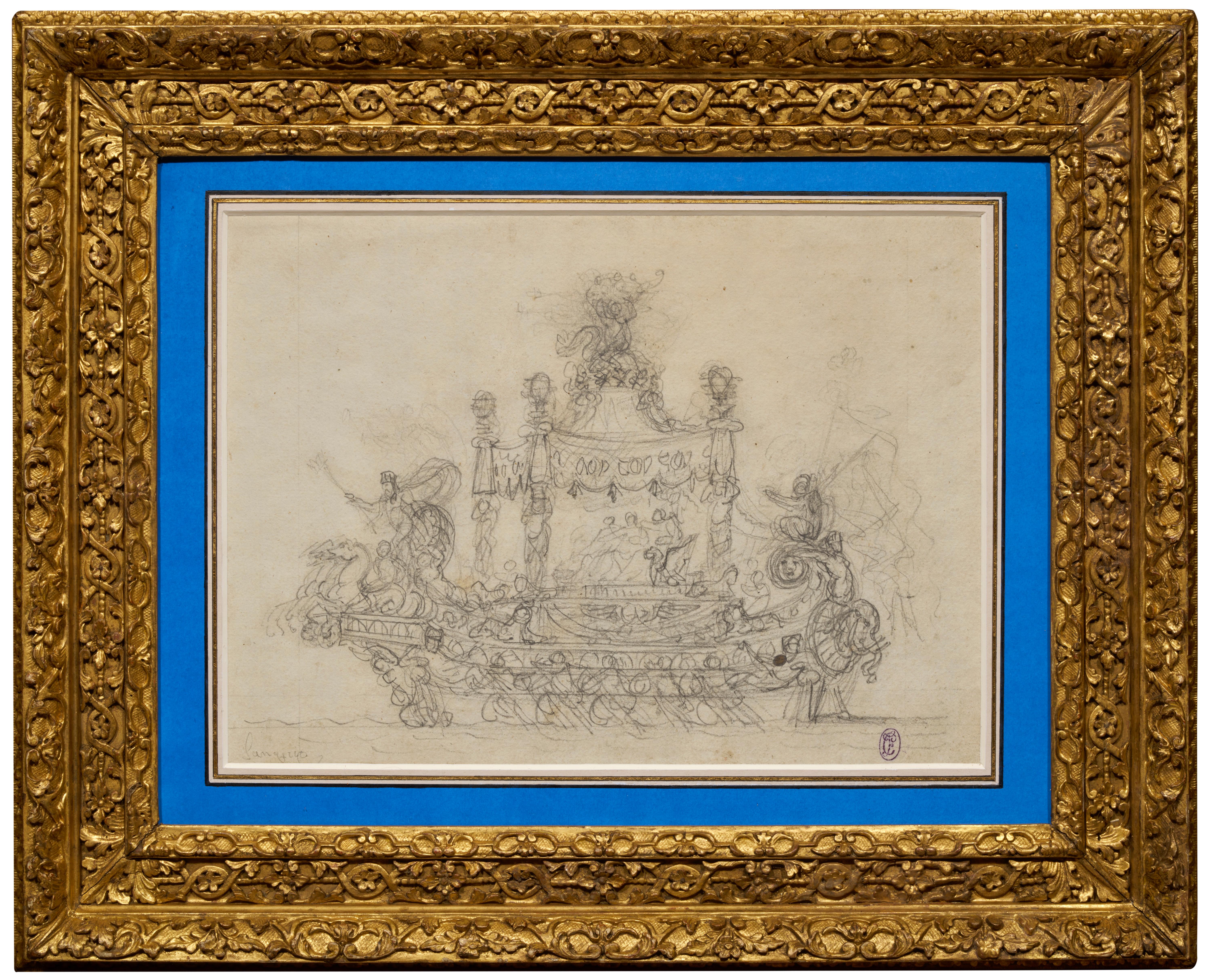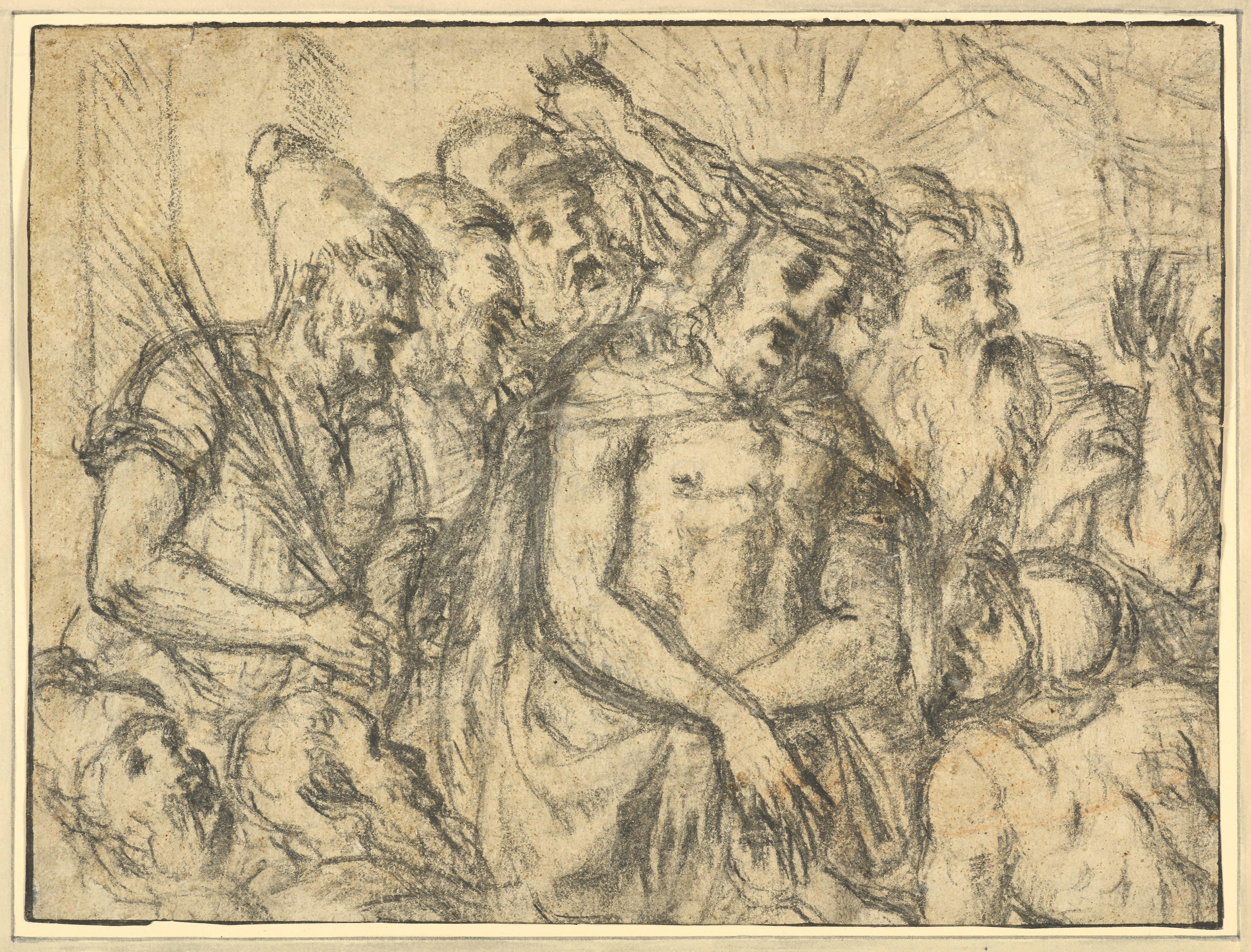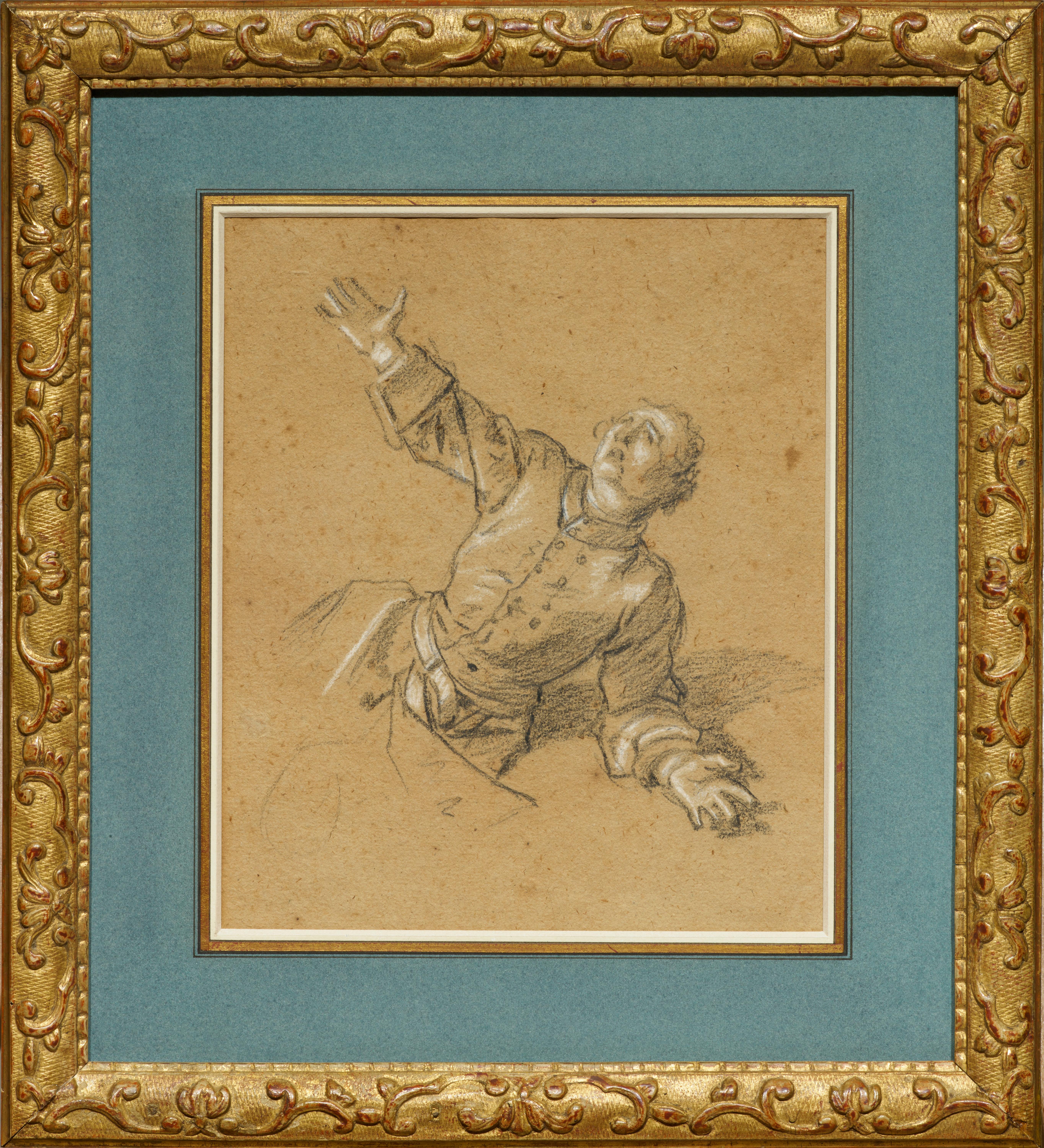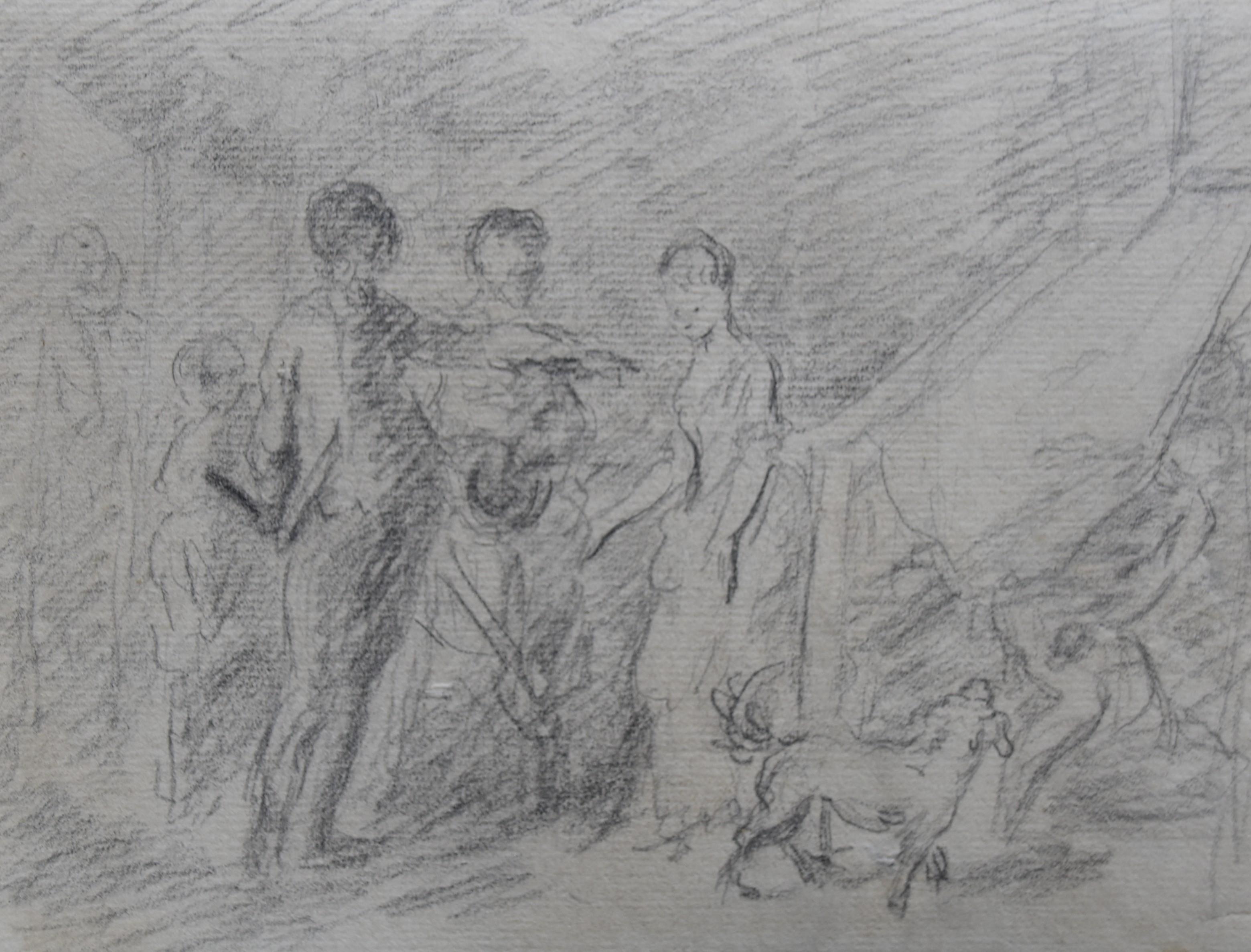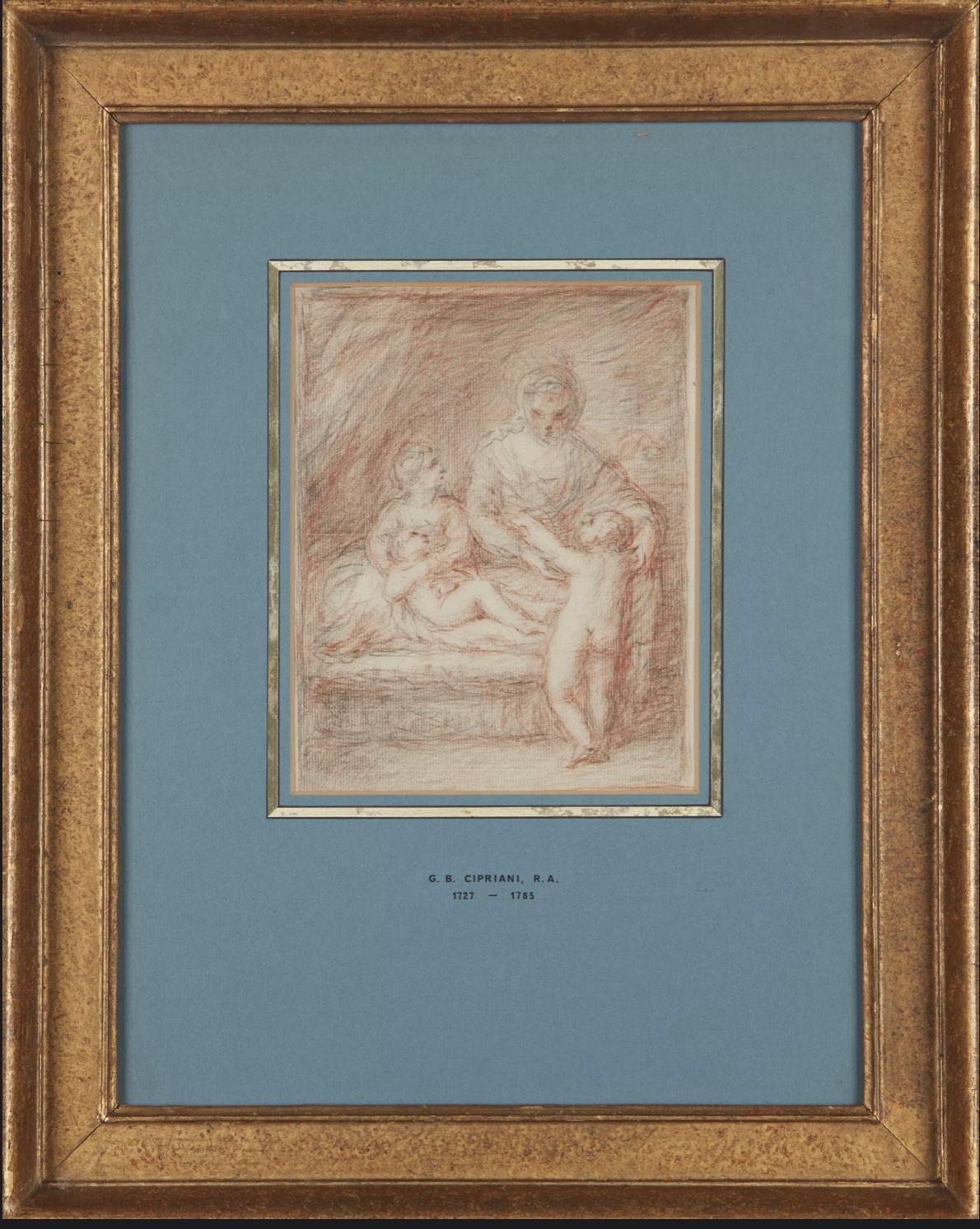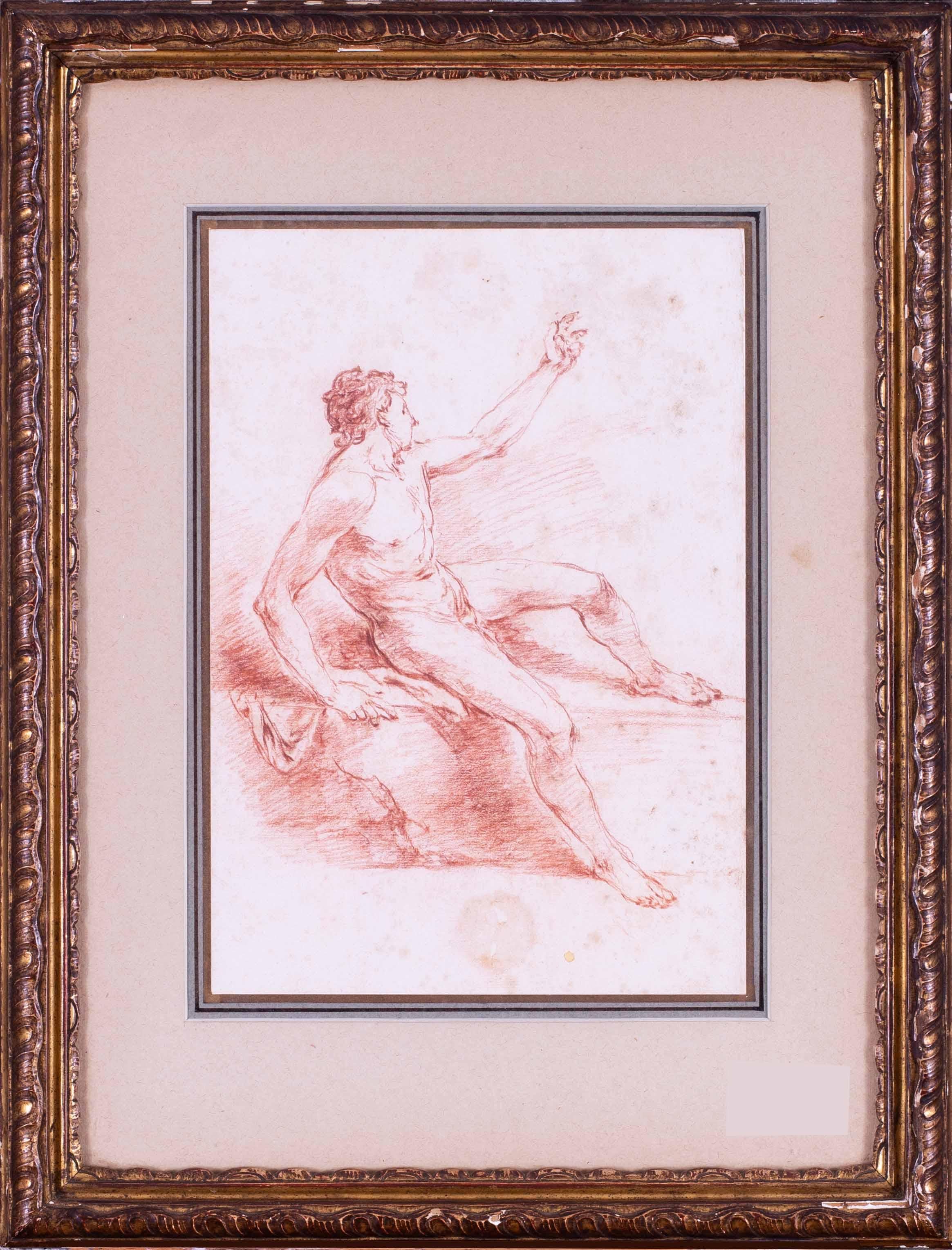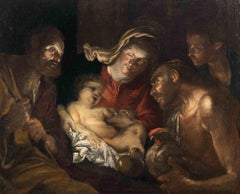
The Abduction Of Europe - Original Drawing on paper in red chalk
Want more images or videos?
Request additional images or videos from the seller
1 of 5
UnknownThe Abduction Of Europe - Original Drawing on paper in red chalk 18th century
18th century
About the Item
- Creation Year:18th century
- Dimensions:Height: 16.34 in (41.5 cm)Width: 12.41 in (31.5 cm)Depth: 0.04 in (1 mm)
- Medium:
- Movement & Style:
- Period:
- Framing:Framing Options Available
- Condition:Insurance may be requested by customers as additional service, contact us for more information.
- Gallery Location:Roma, IT
- Reference Number:Seller: M-1013961stDibs: LU65034381272
About the Seller
4.9
Platinum Seller
These expertly vetted sellers are 1stDibs' most experienced sellers and are rated highest by our customers.
1stDibs seller since 2017
6,757 sales on 1stDibs
Typical response time: 2 hours
More From This SellerView All
- The Adoration -Painting by Giuseppe Assereto - 1630By Giuseppe AsseretoLocated in Roma, ITThe Adoration is an original modern artwork realized by Giuseppe Assereto (died in Genoa in 1650) in the first half of the 17th Century. Original Oil Painting on Canvas. A 19th Century style gilded wood frame is included. The Autograph of the work was confirmed by Camillo Manzitti. Very good conditions. The frame is in excellent conditions too. Reference: C. Marcenaro, Pittori genovesi a Genova nel '600 e nel '700, Genova 1969, pp. 134 ; 135, n. 55. Z. Wazbinski, Un Quadro Caravaggesco Di Gioacchino Assereto, in Prospettiva, n. 26, 1981, pp. 60 ; 63. F. R. Pesenti, La Pittura in Liguria. Artisti del primo Seicento, Genova 1986, p. 397, nota 23. A. Gesino, Tracce di Matthias Stom nel collezionismo tra la Sicilia e Genova, in Caravaggio e i genovesi, catalogo della Mostra a cura di A. Orlando, Genova 2019, pp. 182 ; 195. The Adoration is an excellent example of the XVII Century Italian Painting. The style of the work denotes the suggestive influence of Assereto father's mature production, when influenced by Mathias Stom (Amersfoort, about 1600 - Sicily, after 1650) expresses dark sensibilities in a southern Italian style. In his works, however, there is an accentuated naturalism and interesting similarities with the production of Giovanni Benedetto Castiglione. Gioacchino Assereto died in 1650, while, according to Soprani, he was intent on painting a Last Supper for the oratory...Category
1630s Old Masters Figurative Drawings and Watercolors
MaterialsOil
- Ruines Romanes - Roman Ruins - Ink and Watercolor by J. P. Verdussen - 1742By Jan Peeter VerdussenLocated in Roma, ITChina ink and watercolor on paper. Hand dated. Conditions: Foxing on the top right of the paperCategory
1740s Old Masters Figurative Drawings and Watercolors
MaterialsInk, Watercolor
- La Bataille - The Battle - Drawing by J. P. Verdussen - 1740sBy Jan Peeter VerdussenLocated in Roma, ITChina ink and watercolor on paper. Conditions: Two cuts on the centre of the paper. Three holes on centre-right, botton-left and top-left of the paper. Worn on the top left of the ...Category
1740s Old Masters Figurative Drawings and Watercolors
MaterialsInk, Watercolor
- La Campagne de Rome - Roman Countryside - Drawing by J. P. Verdussen - 1740caBy Jan Peeter VerdussenLocated in Roma, ITChina ink and watercolour on paper. Realized in 1740 ca. Very good conditions. Includes passepartout.Category
1740s Old Masters Figurative Drawings and Watercolors
MaterialsInk, Watercolor
- Flora Study - Drawing by J. P. Verdussen - End of 18th CenturyBy Jan Pieter VerdussenLocated in Roma, ITWatercolour. Hand-Numbered "312" lower-right on margin. In very good condition except a little stain on the high left corner. Wonderful Watercolour drawing by Jan Peeter Verdussen, s...Category
Early 18th Century Old Masters Figurative Drawings and Watercolors
MaterialsPaper
- Figure of Breton Woman - Drawing by J. P. Verdussen - End of 18th CenturyBy Jan Pieter VerdussenLocated in Roma, ITFigure of Breton Woman is a beautiful ink and watercolor original drawing on wire rod and watermarked paper realized at the middle of XVIII century by Jan Peter Verdussen. This ori...Category
Early 18th Century Old Masters Figurative Drawings and Watercolors
MaterialsPaper
You May Also Like
- The Flight into EgyptLocated in New York, NYInscribed: 3. una Madonna che va in Egitto, verso, and Madonna che va in Egitto, recto Provenance: Private Collection, UK, since 1999 This expressive and boldly executed drawing is the work of Luca...Category
16th Century Old Masters Figurative Drawings and Watercolors
MaterialsInk, Paper, Chalk, Pen
- The Martyrdom of the Santi Quattro CoronatiLocated in New York, NYProvenance: Private Collection, UK After initial training under Justus Suttermans and Vincenzo Dandini, in 1673 Anton Domenico Gabbiani embar...Category
17th Century Old Masters Figurative Drawings and Watercolors
MaterialsChalk, Paper, Ink, Pen
- Three drawings by François Boucher in a mounting by Jean-Baptiste GlomyBy François BoucherLocated in PARIS, FRWe would like to thank Juliette Parmentier-Courreau of the Custodia Foundation for her welcome and support during the consultation of Glomy’s Journal des Ouvrages. This spectacularly large "feuille de desseins ajustés" commissioned by François Boucher from Jean-Baptiste Glomy is emblematic of the painter's art and mastery of rocaille. It is also fully representative of the taste of this period in the field of decorative arts. The largest of these three drawings, placed at the bottom of the composition, is particularly interesting: dating from around 1756, it constitutes a modello (apparently unpublished) for the frontispiece of the "Catalogue des tableaux de Monsieur de Julienne"), preserved in the Morgan Library in New York. 1. François Boucher, the master of French rocaille The extraordinary career of Francois Boucher was unmatched by his contemporaries in versatility, consistency and output. For many, particularly the writers and collectors who led the revival of interest in the French rococo during the last century, his sensuous beauties and plump cupids represent the French eighteenth century at its most typical. His facility with the brush, even when betraying the occasional superficiality of his art, enabled him to master every aspect of painting – history and mythology, portraiture, landscape, ordinary life and, as part of larger compositions, even still life. He had been trained as an engraver, and the skills of a draftsman, which he imbued in the studio of Jean-Francois Cars (1661 – 1738), stood him in good stead throughout his career; his delightful drawings are one of the most sought-after aspects of his oeuvre. As a student of Francois Lemoyne (1688 - 1737), he mastered the art of composition. The four years he spent in Italy, from 1727-1731, educated him in the works of the masters, classics and history, that his modest upbringing had denied him. On his return to Paris in 1734, he gained full membership of the Royal Academy of Painting and Sculpture with his splendid Rinaldo and Armida (Paris, Musée du Louvre). Although, throughout his career, he occasionally painted subjects taken from the Bible, and would always have considered himself first as a history painter, his own repertoire of heroines, seductresses, flirtatious peasant girls and erotic beauties was better suited to a lighter, more decorative subject matter. His mastery of technique and composition enabled him to move from large scale tapestry...Category
1750s Old Masters Figurative Drawings and Watercolors
MaterialsChalk, Ink
- A dazzling Venetian Regatta Boat Study attributed to Alessandra MauroLocated in PARIS, FRThis stunning Baroque study depicts a regatta boat, a type of vessel developed in eighteenth-century Venice for the regattas organized by the Serenissima during visits by royalty and...Category
Mid-18th Century Old Masters Figurative Drawings and Watercolors
MaterialsChalk
- Christ before Herod, a drawing from the School of TitianLocated in PARIS, FRThis vigorous drawing is clearly inspired by the numerous compositions on the Ecce Homo theme which were produced by Titian and his workshop at the painter's maturity. However, the number of characters and their expressionist treatment, the many variations to Titian's paintings reveal a drawing made by an original artist, perhaps of foreign origin, belonging to the peripheral circle of the "Titian solar system”, as described by the art historian Enrico Maria del Pozzolo. 1. Titian, the leading artist of 16th century Venetian painting and his botteghe Tiziano Vecelli (or Vecellio), known as Titian, was born between 1489 and 1490 in Pieve di Cadore in the Veneto region of Italy into a wealthy family of soldiers and lawyers. At the age of 15, he joined the studio of Giovanni Bellini, where he became friend with Giorgione, ten years his senior. Giorgione introduced him to a new pictorial style in which forms are defined by colour and pictorial substance, freeing himself from the meticulous underlying drawings characteristic of Bellini's painting. Titian became the official painter of the Republic of Venice upon Bellini's death in 1516. In 1518, the completion of his Assumption for the church of Santa Maria Gloriosa dei Frari in Venice established his reputation as the leading painter of the Venetian school: throughout his career, Titian had a considerable impact on other artists of his time, whether they were direct collaborators, occasional contributors, or other artists under his influence. Considered one of the greatest portraitists of his time, his fame spread throughout Europe and he became the official painter of the greatest European families: the Gonzagas, the Farneses (Alessandro Farnese, of whom he executed several portraits, was elected pope in 1534 under the name of Paul III), the Habsburgs (he went to Augsburg in 1548 to paint the portrait of Charles V and King Philip II of Spain, his successor, later became the artist's main patron). As Titian almost reached the age of 90 years, he saw during his lifetime the death of many of his loved ones (his wife Cecilia, his brother Francesco and his son Orazio). A pathetic feeling appears in his late artworks, such as his famous Pieta, his last work intended to decorate his tomb which remained unfinished. Titian's success was also based on the establishment of a large and versatile workshop, which, alongside the traditional assistance in the production of certain paintings, ensured the publication of numerous woodcuts, allowing the master's works to be widely distributed. Long ignored by art historians, the individual stories of these various collaborators, the organisation of this workshop and the interactions of the collaborators with the master are at the heart of contemporary studies on the artist. 2. A complex composition with expressionist overtones Executed with great virtuosity in black chalk, the composition of our drawing is complex, even slightly confused and probably reflects several phases of execution, if not several hands. The scene is organised around the characters of Christ and an executioner wearing a Phrygian cap. Christ is presented at mid-body, slightly at an angle, his torso bare, his shoulders draped in a cloak, his hands clasped together and probably bound. His head, as if weighed down by the crown of thorns, is slightly bent forward. The eyes and mouth are hollowed out by the black chalk to better express his sorrow. The man wearing a Phrygian cap holds a whip in his right hand, while his left hand, barely outlined, seems to be pulling aside Christ's tunic as if he were about to scourge him. Two other men, who may have been added at a later stage, occupy the space between the executioner and Christ. One is depicted in profile, while the one behind Christ appears to be wearing a military helmet. In an indistinct gesture, his left arm is raised as if to strike Christ. Slightly behind Jesus on his left side, appears a bearded old man wearing a turban. With his left arm raised, he holds out the palm of his hand in a gesture of amazement. His face is finely executed and contrasts with the hand depicted in a rather crude manner. This character may also have been added at a later stage, as he does not fit in perfectly behind the group formed by Jesus and his executioner. This frieze is completed in the left foreground by two additional figures depicted in three-quarter view. Soberly sketched but with great fluidity, only their heads emerge, as if Christ and his executioners were situated on a pedestal above a large crowd. Finally, on the right-hand side of the composition, a second helmeted soldier is depicted. His musculature can be seen under his armour while he stares intently at Christ. He is smaller than the other figures, even though he appears in the front row, revealing a certain clumsiness on the part of the artist. 3. Ecce Homo, one of Titian’s favourite subjects in his twilight years In 1543, Titian tackled the theme of the Ecce Homo in a masterly composition now in the Kunsthistorisches Museum in Vienna. Christ is presented by Pilate, dressed in an antique costume, at the top of a staircase, in a large, highly architectural setting animated by a crowd of characters. The title of the painting refers to a passage from the Gospel of St John (19, 1-5): “Then Pilate took Jesus and had him flogged. The soldiers twisted together a crown of thorns and put it on his head. They clothed him in a purple robe and went up to him again and again, saying, “Hail, king of the Jews!” And they slapped him in the face. Once more Pilate came out and said to the Jews gathered there, “Look, I am bringing him out to you to let you know that I find no basis for a charge against him.” When Jesus came out wearing the crown of thorns and the purple robe, Pilate said to them, “Here is the man!” From the 1540s onwards, Titian and his workshop repeatedly depicted the Christ of Sorrows for their principal patrons. In these paintings, Titian returned to the half-body format that he had practically abandoned since 1520 and refocused the composition (compared to the large 1543 Ecce Homo) on the figure of Christ, who is depicted alone or accompanied by a few figures. With his eyes lowered and his head slightly bowed, Titian's Christ seems calmly resigned to his fate. Powerless and submissive, he arouses deep pathos from the viewer. The tondo in the Louvre Museum shows Christ in a position very similar to that of our drawing, a position that will be found in most of Titian's Ecce Homo. To his right stands a helmeted soldier who seems to be baring his shoulder and to his left a servant of Pilate wearing a Phrygian cap. These two figures are reminiscent of the soldier in the lower right corner and the executioner in the left most part of our drawing. Various versions were executed by Titian and his workshop until the late 1560s, and the version that seems closest to the right-hand side of our drawing is the one in the Prado Museum. Although of uneven quality, it is interesting to note the gesture of Pilate's hand, holding out the palm of his left hand towards the viewer, as if to distance himself from the decision that the crowd will make. Recent X-rays of the painting have shown that the executioner on the right, depicted from behind, was originally depicted in profile (as in our drawing), and that the other two figures (Pilate on the left of Christ and a servant wearing a Phrygian cap on his right) were added later. The painting was then organised around the diagonal that crosses the canvas from left to right, emphasised by the light coming from the window, and centred on the exchange of glances between Christ and the executioner on his left. The profile of the old man in the foreground on the left could be inspired by that of the elderly Titian as it appears repeatedly in the painter's late artworks, such as the Madonna of Mercy in the Palatine Gallery. 4. A deeply original drawing, at the risk of confusion We saw in the last paragraph the various borrowings from Titian's depictions of the Ecce Homo that can be found in this drawing: the position of Christ, the presence of executioners wearing Phrygian caps and of helmeted soldiers, one of whom is looking at Christ in a position that evokes the repentance visible with X-ray in the Madrid painting...Category
16th Century Old Masters Figurative Drawings and Watercolors
MaterialsChalk
- Study of a Fate at mid-body, a red chalk attributed to Giovanni da San GiovanniLocated in PARIS, FRThis spectacular red chalk drawing depicts an elderly woman, her eyes bulging, her hand stretched out towards the sky. This disturbing character, who seems close to dementia, and the elongation of her arm with its Mannerist overtones, plunge us into the Florentine artistic milieu of the first half of the 17th century. The proximity of this drawing to some characters in the fresco in the Pitti Palace representing The Muses, Poets and Philosophers chased from Parnassus, the last masterpiece of Giovanni da San Giovanni, leads us to propose an attribution to this artist and a dating of around 1635-1636. 1. Giovanni da San Giovanni, the painter of contradiction We take here the title of the monography dedicated to the artist by Anna Banti in 1977, which remains the reference book for this artist. The son of a notary, Giovanni Mannozzi, known as Giovanni da San Giovanni, abandoned his studies to go to Florence at the age of sixteen, where he entered the studio of Matteo Rosselli (1578 - 1650) around 1609 and enrolled in the Academy of Drawing Arts in 1612. Around 1615 he produced his first known works, mainly frescoes for the city's tabernacles. He became famous in Florence for his originality, combining an obsessive application to the study of drawing and the reading of poetry and history with a disheveled appearance. Between 1619 and 1620 he decorated the facade of the Antella Palace in Piazza Santa Croce, a decoration that still partly survives today. The death of Cosimo II in 1621 put an end to the Florentine building activity and Giovanni da San Giovanni left for Rome to find other sponsors with the painter Francesco Furini...Category
17th Century Old Masters Nude Drawings and Watercolors
MaterialsChalk
